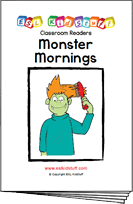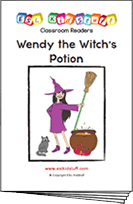Describing people (adjectives) lesson plan
Stand-alone lesson ESL kids lesson plan
Lesson plans for ESL kids teachers
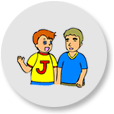
Describing people (adjectives)
In this lesson students practice describing people using common adjectives. Students learn new adjectives, practice describing themselves and others, do a listening activity, play fun games and do a class survey.
Members get accompanying worksheets, song and classroom reader.
Download materials:
Our lesson plans are FREE!
Sign up for accompanying:
✔ worksheets
✔ homework sheets
✔ craft sheets
✔ flashcards
✔ song downloads & videos
✔ classroom readers & videos
Click to see lesson details, materials and supplies
Time: 40 mins – 1 hour
Objectives: Describing people using adjectives.
Structures: “What does s/he look like?”, “Tell me all about him/her”, “He/She is/[hide_on_uk]has[/hide_on_uk][hide_on_us]has got[/hide_on_us]”.
Target vocabulary: tall, short, long hair, short hair, brown eyes, blue eyes, blonde hair, black hair, s/he is great.
Lesson materials
Printables:
- Describe your friend worksheet 1 or Describe your friend worksheet 2
- Describe your friend class survey worksheet
- Describe your family worksheet
- Reader worksheet
- Describe your friend song poster
Songs:
- Describe your friend
Readers:
- The clever prince
Additional materials:
- Describing people vocab crossword
- Describing people vocab word search
- Describe your friend worksheet
Supplies:
- [hide_on_uk]colored[/hide_on_uk][hide_on_us]coloured[/hide_on_us] pencils
- blank A4 paper – 1 per student
- magazine cut out pictures of people
- whiteboard or blackboard with as many different [hide_on_uk]color[/hide_on_uk][hide_on_us]colour[/hide_on_us] markers / chalk as possible
- device to play the song on
A lesson on descriptive adjectives and 3rd person ‘he/she’ and includes a lively song about describing your best friend.
Lesson procedure:
Warm up and maintenance:
The beginning of your lesson is extremely important: this is where you set the tone of your lesson and get everyone in the right frame of mind for learning English. It is also an opportunity to check homework and review previous lessons.
Click for warm up suggestions for the start of your lessons
These activities can be done in the following order at the start of your lesson:

1. Greetings and name tags
Greet the students by name as they enter the classroom and gesture for them to sit down. Before class prepare some blank name tags (stickers or pin-on tags). Give these out and have everyone write their names and put their tags on. If you use pin-on tags, you can keep and give out every class.

2. Homework check
Check each student’s homework set in the last lesson. Ask each student some questions about their homework worksheet (e.g. “what [hide_on_uk]color[/hide_on_uk][hide_on_us]colour[/hide_on_us] is it?”), give lots of praise, and then put some kind of mark on the homework sheet (e.g. a sticker, a stamp or draw a smiley face). Finally, tell your students to put their homework back into their bags.
3. Review past lessons
Reviewing past lessons is very important – students need constant practice of new vocab, structures, songs, games and so on. Always review parts of your last lesson as well as some parts from other previous lessons. You can spend 5-10 minutes reviewing – it’s fine to recycle games and activities from your past lessons to review as kids enjoy playing familiar games (although be careful not to play a game to death!). See the section “Other ideas to include in your warm” below for ideas.
You can also include review activities in the main body of your lesson. Kids can have short attention spans so it’s good to be able to pull out lots of activities during different stages of the lesson.
Other ideas to include in your warm up:
Ball pass questions
This is good to review questions from previous lessons. Get everybody standing in a circle.
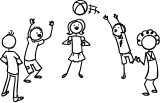
Round 1:
Take a ball and hold it and say, “My name is (you name)”. Then throw the ball to one student and say, “What’s your name?”. Students throw the ball around randomly, saying their names and asking for names.
Round 2:
This time ask a review question, e.g. “How many tables are there?”. Then throw the ball to a student who should answer, “There are (6) tables”. Help if necessary. Then that student throws the ball to another student and asks a “How many …?” question. Continue so everyone has a go. You can have multiple rounds with different topic questions.

Play “Spin the bottle”
Sit students in a circle with a bottle in the middle. Teacher spins the bottle. When it stops spinning the student it is pointing to has to answer a question. If the answer is correct then that student can spin the bottle. This is a good class warm up activity (e.g. How are you? What’s your [hide_on_uk]favorite[/hide_on_uk][hide_on_us]favourite[/hide_on_us] food? How’s the weather today?, etc.
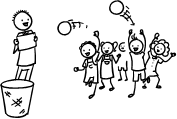
Play “Vocabulary basketball”
This is a fun game which reviews vocabulary from previous lessons. You will need a basket (a trash can) and 2 balls (or 2 pieces of A4 paper scrunched up into balls).
Form 2 teams and line them up so that two players from each team are facing the front with the basket in front of them. Let both players throw their ball – if they get their ball into the basket they can try and win a point by giving the correct answer to a question the teacher asks. This can be an actual question (e.g. What are you wearing?) or a flashcard (What’s this?). Then they go to the back of the line. At the end, the team with the most points is the winner!
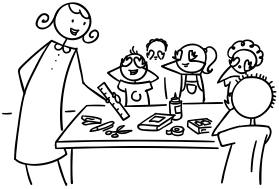
Play “What’s missing?”
This is a fun review memory game – students will have to try to remember review objects from previous lessons (e.g. classroom stationery). Lay the objects out on a table for all to see. Allow the students a minute to memorize the positions of the objects. Remove an object and hold it behind your back. Say, “Open your eyes!” – the first student who can shout out the missing object wins a point for his/her team. Play for all the objects.
Finally, calculate which team has won the most points and give them a round of applause.

Play “Quiz game show”
This is a fun quiz game, like a simple version of a TV game show. Draw some circles on the board and randomly write numbers 1, 2 or 3 in each circle. These will be points.
Put students into teams. Then ask the first team to choose a number – 1 is an easy question (e.g. “Do you like bananas?”) and 3 is a difficult question (e.g. point at a clock and ask, “What time is it?”). 2 will be in between in terms of difficulty. When the question has been answered correctly, erase that number circle. Play until all the number circles are gone – the team with the most points is the winner!
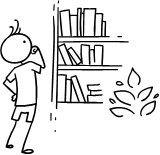
Read a classroom reader again
As you progress through the lessons you will start to build up a catalog of classroom readers (see our Readers download page at https://www.eslkidstuff.com). Kids love going back to old stories and reading through them again. Invite a student to pick a classroom reader and read through it as a class. Make the story as interactive as possible by asking questions (e.g. what [hide_on_uk]colors[/hide_on_uk][hide_on_us]colours[/hide_on_us] there are, the names of different objects, etc.) and getting students to speculate what is going to happen next in the story.

Talk about the weather (do after you have taught the weather lesson plan).
- Prepare a weather board. Before the first class prepare a piece of cardboard and cover it with felt – you are going to pin this to the wall. If you can, try and get blue felt (to represent the sky). Write at the top in large letters, “How’s the weather today?”. Below that write “Today it’s”. Cut out weather pictures (such as our weather flashcards) and stick some velcro on the back. Arrange the weather pictures around the edge of the board and then put the board on the wall of your classroom. You can now use this weather board at the beginning of every lesson.
- Ask about the weather. Ask, “How’s the weather today?” and have students put up their hands. Allow one weather condition per student (e.g. “It’s rainy”) and have each student come up and put a weather picture on the weather board.
- Introduce more weather vocabulary. Depending on weather conditions, you can introduce more weather words (with pictures … you can get students to draw them), such as:
- stormy
- misty
- showery
- freezing
- humid
- frosty
- icy
- drizzly
New learning and practice:
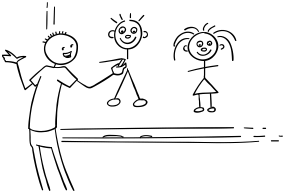
1. Introduce the descriptions vocab
For this lesson you are going to use your artistic drawing skills. Use a whiteboard or blackboard to draw the following:
- At the top of the board draw 2 circles (these will be the heads). Elicit “circles”.
- On each head draw a nose, ears and a mouth. Elicit each as you draw them. Then ask, “What’s missing?”.
- Elicit “eyes”. Ask, “What [hide_on_uk]color[/hide_on_uk][hide_on_us]colour[/hide_on_us] are they?” and give the students the options of the [hide_on_uk]colors[/hide_on_uk][hide_on_us]colours[/hide_on_us] of markers / chalk you have. Then draw the eyes in the chosen [hide_on_uk]colors[/hide_on_uk][hide_on_us]colours[/hide_on_us] with different [hide_on_uk]colors[/hide_on_uk][hide_on_us]colours[/hide_on_us] for each set of eyes (NB: it’s ok to have strange [hide_on_uk]colors[/hide_on_uk][hide_on_us]colours[/hide_on_us], such as yellow, for the eyes – this will just make it more fun).
- Elicit “hair” and again ask “What [hide_on_uk]color[/hide_on_uk][hide_on_us]colour[/hide_on_us] is it?”. On one head draw long hair in one [hide_on_uk]color[/hide_on_uk][hide_on_us]colour[/hide_on_us] (for the girl) and on the other draw short hair (for the boy) in a different [hide_on_uk]color[/hide_on_uk][hide_on_us]colour[/hide_on_us]. Teach / Elicit “long / short hair”.
- Finally, you’ll need to draw 2 bodies. But rather than you draw them you are going to ask for 2 volunteers to do the drawings. For the girl, draw some shoes quite near the head (so that she will be short) and for the boy draw some shoes right down at the bottom of the board (so he will be tall). Have the students draw the bodies so that they join the heads with the shoes. Now teach / elicit “tall / short”.
It should end up looking something like this:
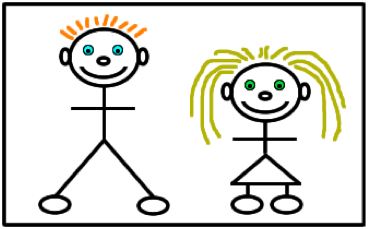
- Now that the completed pictures are on the board, chorus 3 times the following sentences and point to the pictures as you do:
- He is tall.
- [hide_on_uk]He has[/hide_on_uk][hide_on_us]He’s got[/hide_on_us] short hair.
- [hide_on_uk]He has[/hide_on_uk][hide_on_us]He’s got[/hide_on_us] (blue) eyes.
- [hide_on_uk]He has[/hide_on_uk][hide_on_us]He’s got[/hide_on_us] (orange) hair.
- She is short.
- [hide_on_uk]She has[/hide_on_uk][hide_on_us]She’s got[/hide_on_us] long hair.
- [hide_on_uk]She has[/hide_on_uk][hide_on_us]She’s got[/hide_on_us] (green) eyes.
- [hide_on_uk]She has[/hide_on_uk][hide_on_us]She’s got[/hide_on_us] (brown) hair.
2. Do “Funny body” drawings
Give a piece of A4 paper to each student and yourself.
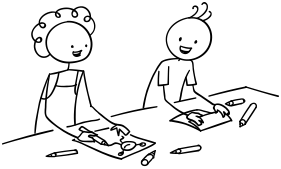
- On your piece of paper, model drawing a head with eyes, nose, ears, mouth, teeth and hair. Make it a really funny picture. Then tell everyone to draw their funny head. Make sure they use [hide_on_uk]colors[/hide_on_uk][hide_on_us]colours[/hide_on_us] for the eyes and hair.
- Next show them how to fold the paper so only the neck shows (so the head is folded behind). Then get everyone to pass their paper to a different student.
- Now model drawing the body starting from the neck and going down to ankles – make it either a really short or long body and make it as funny as you can. Now have your students draw their bodies.
- Again, show everyone how to fold the paper so only the ankles are showing and have everyone pass their paper to another student.
- Finally, model drawing funny feet and get everyone to draw feet on their pictures. Then get everyone to fold up their papers and return each piece to the person who drew the head.
- Let everyone open up their paper and have a good laugh at the pictures. Now ask everyone to “present” their person in the drawing to the rest of the class – you model first (e.g. “This is Tom. He is short. [hide_on_uk]He has[/hide_on_uk][hide_on_us]He’s got[/hide_on_us] pink hair, etc.”).

3. Play the “Describe your friend” song and do the active listening worksheet
Tell the class that they are going to listen to a song about a boy and a girl. Give out either “Describe your friend worksheet 1” or “Describe your friend worksheet 2” (worksheet 2 is better if you cannot print out [hide_on_uk]colored[/hide_on_uk][hide_on_us]coloured[/hide_on_us] worksheets).
Read the instructions to the class and then play the song. As the song is playing students should do the worksheet activity. Play the song again if required. Finally, go through the song one more time stopping to check answers.
If everyone enjoyed the song, you can play it again and have everyone sing along (especially as it’s such a catchy tune!).
Lyrics for “Describe your friend”
Tell me about your best friend!
Chorus:
What does he look like?
What does he look like?
Tell me all about him.
Verse 1:
He is tall
[hide_on_uk]He has[/hide_on_uk][hide_on_us]He’s got[/hide_on_us] short hair
[hide_on_uk]He has[/hide_on_uk][hide_on_us]He’s got[/hide_on_us] brown eyes
[hide_on_uk]He has[/hide_on_uk][hide_on_us]He’s got[/hide_on_us] blonde hair
But most of all, he is great!
Tell me about your best friend!
Chorus:
What does she look like?
What does she look like?
Tell me all about her.
Verse 2:
She is short
[hide_on_uk]She has[/hide_on_uk][hide_on_us]She’s got[/hide_on_us] long hair
[hide_on_uk]She has[/hide_on_uk][hide_on_us]She’s got[/hide_on_us] blue eyes
[hide_on_uk]She has[/hide_on_uk][hide_on_us]She’s got[/hide_on_us] black hair
But most of all, she is great!
Gestures for “Describe your friend”
There are no gestures for this song – a listening activity with worksheets accompanies the song instead. However, if students enjoy the song you can encourage them to sing along and dance!
For the active listening activity use either of the following worksheets:
- “Describe your friend worksheet 1” is a ‘listen and circle what you hear’ exercise.
- “Describe your friend worksheet 2” is a ‘listen and draw’ exercise (this is better if you can’t print out the [hide_on_uk]color[/hide_on_uk][hide_on_us]colour[/hide_on_us] worksheet 1)
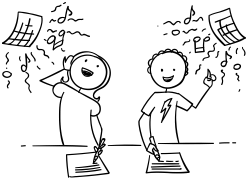
[hide_on_uk]Short sample (members get full-length song):
[/hide_on_uk]
[hide_on_us]Short sample (members get full-length song):
[/hide_on_us]
4. Do the “Describe your friend class survey” worksheet
This will give your students the chance to use the lesson structures. Give out the class survey worksheet. Each student should work on their own for a few minutes looking at their classmates and filling in the table about 6 of their friends in the class. Whilst they are doing this, circulate and check and ask questions.
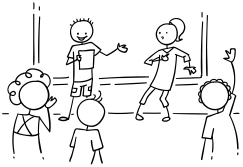
Finally, once everyone has finished, ask each student to describe some of their friends: Ask, “Tell me about your friend”, “What does he / she look like?”.
Finally, put students in pairs to practice asking about their classmates.
Additional activity: Have your students ask about and describe family members (e.g. brothers, sisters, parents, grandparents, etc.).

5. Read classroom reader “The clever prince”
Before class, download and print off the reader “The clever prince” and enough reader worksheets for each student. First, give each student a worksheet and have pairs read the descriptions of the characters from the story and draw what they think they will look like. Then as you read through the story students can check how close their drawings are to the character pictures.
As you go through each page, point to the pictures, elicit adjectives to describe the characters in the story:
Teacher: (pointing to the picture of the princess on page 1) Who is this?
Students: A princess?
Teacher: Yes, that’s right! And what does she look like? (elicit description adjectives)
Students: [hide_on_uk]She has[/hide_on_uk][hide_on_us]She’s got[/hide_on_us] long, blond hair.
Teacher: Yes! And she is very beautiful, isn’t she?
Students: Yes!
Get the students really involved in the story by asking lots of questions such as what the animals (real and fictional) are and what everyone thinks the prince should do to rescue the princess.
Alternatively, watch our video version of the reader (Internet connection required).
6. Play “Guess who?”
For this activity, you’ll need lots of magazine pictures of people. Try and get lots of different types of people pictures, with different [hide_on_uk]color[/hide_on_uk][hide_on_us]colour[/hide_on_us] eyes and hair. The more pictures you can find and cut-out before class the better (Note: This is a great resource to have for future lessons, as people pictures can be used in many different ways).
In class, lay out all of pictures on the floor or on a large table. Start by saying, “My friend [hide_on_uk]has[/hide_on_uk][hide_on_us]has got[/hide_on_us] (short, brown) hair, he is (tall) and [hide_on_uk]he has[/hide_on_uk][hide_on_us]he’s got[/hide_on_us] (green) eyes”. Everyone should try and guess which picture you are describing. You can also give additional clues (clothes, etc.). The student who guesses correctly can then have a go describing someone.
Now that everyone has got the idea of the game, put students into small groups and have them play the game together. Whilst they are playing, monitor, help and encourage the use of the lesson structures.

Wrap up:
Assign homework: “Describe your family” worksheet
Click for wrap up suggestions for the end of your lessons

1. Assign homework
Each week give out a homework worksheet for your students to take home. Hold up the homework worksheet and model how to do it. Give out the worksheets and say, “Put your homework in your bags”.

2. Do “Quick check”
Time to leave the class. Make sure everything is put away and the students have gathered their belongings. Have them line up at the door and place yourself between the door and the students. For each student check one new word or phrase, for example:
- hold up an object or flashcard (such as an item of clothing) and ask, “What’s this?”
- ask a question from the lesson (e.g. “Where do you live?”, “Do you like bananas?”, “Can you play chess?”, etc.)
When they give you the correct answer say goodbye and let them leave. If their answer is wrong, have them go back to the end of the line – they will have to try again once they reach the front!
Other lesson plans
Actions, verbs & tenses:
- Can – for ability
- Morning routines
- Daily routines & times of the day
- Actions – Present continuous
- Future plans using “going to”
- Past tense activities – Regular verbs
- Past tense activities – Irregular verbs: Part 1
- Past tense activities – Irregular verbs: Part 2
Adjectives:
- Describing people
- Describing things
- Comparing things (Comparative adjectives)
- Comparing things (Superlative adjectives)
Adverbs:
Alphabet:
Animals:
Body:
Classroom:
Clothes:
Colors:
Colours:
Directions:
Family:
Feelings & emotions:
Food:
Health & sickness:
Holidays & festivals:
Jobs:
Likes, dislikes & favorites:
Likes, dislikes & favourites:
- Likes & dislikes
- [hide_on_uk]Favorites[/hide_on_uk][hide_on_us]Favourites[/hide_on_us] and asking why
Nature & Our world:
Numbers:
Places & where we live:
Prepositions of location:
Pronouns:
Shapes:
Shopping:
Sports:
Time, days, months, seasons:
Toys:
Transport & travel:
Weather:




